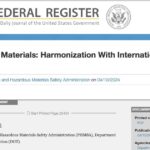To no surprise, the East Palestine, Ohio train derailment that started a weeks-long hazmat incident brought in resources from far and wide.
Western Reserve Joint Fire District Fire Chief David “Chip” Comstock told WFMJ that more than 60 fire departments and hazmat teams from around the region descended on the area to help contain the fire and chemical leak.
And like many large-scale incidents in the past, a big problem was communication.
Also Read: How to Manage a Train Wreck and Other ‘Big Ones’
“We don’t have the ability to communicate with other departments. It becomes a life threatening issue by not having that system,” Comstock said.
Ohio has what it calls a Multi-Agency Radio Communication System, or MARCS, that departments can buy into.
“The state of Ohio brought in its mobile communication system with additional radios to hand out because East Palestine and Columbiana Counties don’t have that system available to them,” Comstock said.
The problem, WFMJ reports, is that the county would need to spend $4 million to upgrade its towers and communication system. On top of that there is a monthly $10 per radio fee, which can be cost prohibitive for smaller, volunteer fire departments.
“We think lawmakers should look at the MARCS, Multi-Agency Radio Communication System, affordable and make sure the infrastructure is built properly for rural uses,” Comstock told WFMJ.
Also Read: Prolonged Hazmat Operations at Ohio Train Derailment
Vance Bennett is an emergency management coordinator and hazmat expert out of California. He says one of the issues with large-scale incidents is that responders have to make decisions with imperfect information. And the inability to communicate only amplifies that problem.
“Making good decisions requires accurate information,” Bennett tells Hazmat Nation. “In the East Palestine incident … had they used ALOHA or PEAC to predict the spread of airborne contaminants the software would have asked for information like the size of the hole in the tank, amount of product leaking and where the hole(s) was.
“You would have to climb under the cars to get this information. Climbing under burning railcars is out of the question. How do you get the information you need to get an idea of how far downwind the contaminants will spread? You don’t.
“This is a common occurrence in major incidents. Do you stop and wait to get the information you need? No. You do the best with what you have.”
Also Read: Spotlight: Norfolk Southern Railway Hazardous Materials Unit
Again, having adequate communication tools is only part of the problem of getting the communication right.
“When the COSCO Busan hit the SF/Oakland Bay Bridge the responders were initially told the amount of fuel oil spilled was 350 gallons,” Bennett says. “It turned out to be 35,000 gallons.”
Comstock and other area chiefs are urging lawmakers to understand the risks of not making the communication system widely available.
“If I had the MARCS system, I would communicate with highway patrol on any needed evacuations. I could communicate with the Sheriff’s Department and with every fire department coming in from Ohio areas and as a situation escalated we could talk to the Ohio National Guard on that system,” Comstock said.
Yet Bennett cautions to expect pushback when working with politicians, even following a major crisis when the solution is clear. This is especially true when the incident is still unfolding.
“I was part of the response to the grounding of the American Trader,” Bennett says. The oil from the ship landed on beaches that were easily accessible. At any given time, we had politicians running for everything from dog catcher to governor on the beach.
“They all expect you to drop everything and cater to their every whim. They will place demands on your time that will distract you from managing the incident. Every one of them will insist on talking to the incident commander. Nobody else will do.”
Bennett also advises hazmat teams to train, and to train first-due firefighters, on how to handle the big one. It is important they don’t “follow the cookbook” and expect everything will go as planned.
“Some years back, there was a large chlorine release from a railcar in Festus, Mo.,” he says. “The hazmat team, just as they were trained to do, climbed on top of the car to stop the leak. But the leak wasn’t from the dome; it was from a defective loading hose that was underneath the car. The big one won’t follow the recipe”
Expect people to make mistakes and that things, like communication systems not designed to talk to other agencies, will go wrong.
“A cold storage warehouse in Southern California experienced a leak in their system,” Bennett says. “Like other such facilities, they used anhydrous ammonia as a refrigerant. A fire department entry team surveyed the area of the leak and found a relief valve that was leaking. Due to the limited visibility in the space, they didn’t notice that an identical valve was just a few feet away from the leaking valve. The second entry team entered the room and proceeded to fix the wrong valve.
“After the leak was reported to be fixed someone from the company, without telling anyone, reactivated the system. Three responders were taken to the hospital and three fire chiefs got some unwanted correspondence from OSHA.”
This, of course, is a message not lost on the response leaders in Ohio. Those departments and counties are reviewing plans in case of a train derailment.
“We need to always plan for the worst-case scenario, so reviewing our plans and making sure they’re up to date, we need to do that and I think people are in the process of doing that.” Comstock said.
Original post – Copyright © 2023 HazmatNation.com. Externally linked references may hold their own independent copyright not assumed by HazmatNation











